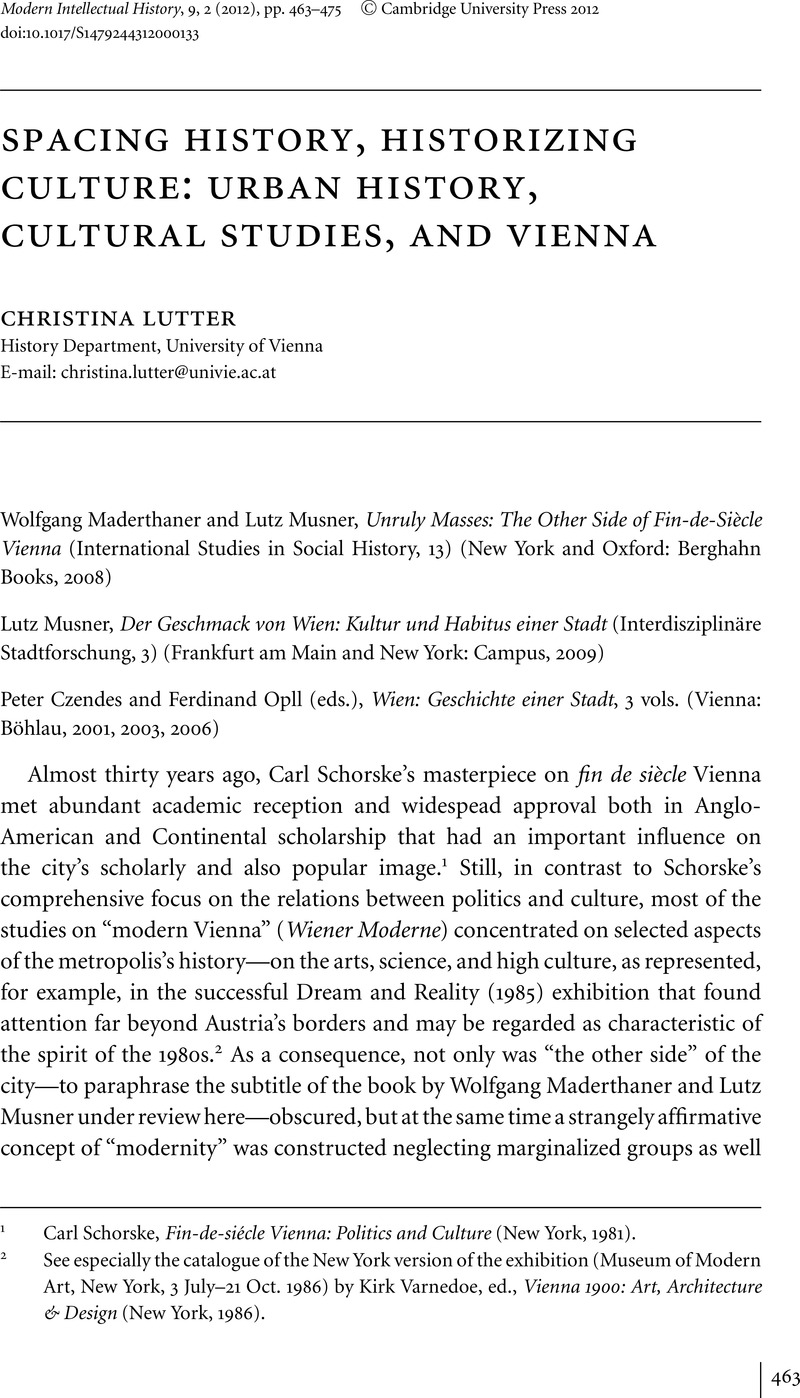No CrossRef data available.
Published online by Cambridge University Press: 10 July 2012

1 Schorske, Carl, Fin-de-siécle Vienna: Politics and Culture (New York, 1981)Google Scholar.
2 See especially the catalogue of the New York version of the exhibition (Museum of Modern Art, New York, 3 July–21 Oct. 1986) by Varnedoe, Kirk, ed., Vienna 1900: Art, Architecture & Design (New York, 1986)Google Scholar.
3 Beller, Steven, ed., Rethinking Vienna 1900 (New York and Oxford, 2001)Google Scholar.
4 See his seminal lecture: Bourdieu, Pierre, “Social Space and the Genesis of ‘Classes’”, in idem, Language and Symbolic Power (Cambridge, 1991)Google Scholar.
5 Bourdieu, Pierre, The Logic of Practice (Stanford, CA, 1990), 55Google Scholar.
6 On the interactions of early modern literacy and orality and popular culture see, e.g., Burke, Peter, A Social History of Knowledge: From Gutenberg to Diderot (Cambridge, 2000)Google Scholar; Chartier, Roger: The Order of Books: Readers, Authors, and Libraries in Europe between the Fourteenth and Eighteenth Centuries (Cambridge, 1994)Google Scholar: as well as e.g. the contributions in Csendes and Opll, Geschichte Wiens, vols. 1 and 2, discussed below, on social and religious conflicts in early modern Vienna.
7 Anderson, Benedict R., Imagined Communities: Reflections on the Origin and Spread of Nationalism (London, 1989)Google Scholar; Boyer, John W., Karl Lueger (1844–1910): Christlichsoziale Politik als Beruf. Eine Biografie (Vienna, 2010)CrossRefGoogle Scholar.
8 Lindner, Rolf, Walks on the Wild Side: Eine Geschichte der Stadtforschung (Frankfurt am Main, 2004)Google Scholar; cf. Patrouch, Joe, “European Cities: Containers or Groups of Inhabitants? A Review of some Recent Developments in Early Modern Urban Studies”, History Compass 7 (2009), 1–13CrossRefGoogle Scholar, for a comparable approach to premodern urban history.
9 Bourdieu, Logic of Practice, 56.
10 Cf. Mitchell, W. J. T., ed., Landscape and Power (Chicago and London, 2002)Google Scholar.
11 Nußbaumer, Martina, Musikstadt Wien: Die Konstruktion eines Images (Freiburg im Breisgau and Vienna, 2007)Google Scholar.
12 Cf. Schmidt-Lauber, Brigitta, Gemütlichkeit: Eine kulturwissenschaftliche Annäherung (Frankfurt am Main, 2003)Google Scholar.
13 Patrouch, “European Cities”, 2, 8.
14 Weber, Max: Wirtschaft und Gesellschaft: Die Wirtschaft und die gesellschaftlichen Ordnungen und Mächte, vol. 5, Die Stadt, ed. Nippel, W. (Tübingen, 1999)Google Scholar; cf. Peter Johanek, “Stadtgeschichtsforschung ein halbes Jahrhundert nach Ennen und Planitz”, in Ferdinand Opll and Christoph Sonnlechner, eds., Europäische Städte im Mittelalter (Innsbruck, 2009), 45–92, 50; and Patrouch, “European Cities”, 6.
15 Cf. Johanek, “Stadtgeschichtsforschung”, 79 ff. for the category of urban networks.